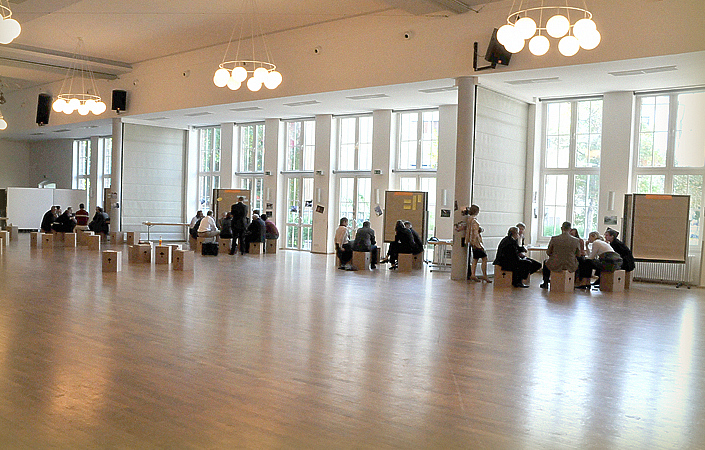20. August 2018

The last years have seen radical change to the environment in which businesses have had to operate for success. The field is increasingly grasped by VUCA – volatility, uncertainty, complexity and ambiguity. Digitalization, globalization and growth of networking generate a degree of complexity that is increasing exponentially and is no longer manageable by traditional methods of leadership and cooperation. This alters the fundamental rules of creating and gathering value.
At the same time, businesses find themselves engaged in a War for Talent in light of a growing scarcity of skilled workers. Employer amenity and employee retention are ever more intensely crucial competitive advantages. Young members of the oft-cited Millenials and Generation Z have raised expectations of their employers. Against the background of an overall cultural development that increasingly emphasizes a striving for autonomy and individualism, they want their experience of life to be a lifetime of learning under ideal work conditions marked by intrinsic motivation and meaningfulness without dominance from above.
Success for a business is therefore defined by that company’s answer to the following two questions: How do we add value by distributing and efficiently tackling tasks under most complex conditions? How can the human factor be reinforced in the company and the potential of intrinsic motivation be meaningfully raised?
The role of management is central to this context. In a new form, it can provide the basis for enabling the above-named two-fold creation of value. Motivational research has identified meaning, autonomy and the sense of improvement as crucial factors of intrinsic motivation (see, for example, Dan Pink). The same factors at the same time support complexity manageability. It is therefore a pivotal component of agile management to design an environment that provides for these three factors to have a maximum impact for the people as well as the success of the company.
Purpose and framework: guides amid complexity
In the VUCA situation, clarity is eradicated by the complexity of stakeholder interests and demand, employees face a new situation every day: clear and firm goals as well as sticking to rules and processes are no longer effective. Instead of a firm distant goal that cascades ‘top down’ along a hierarchy, agile leadership raises an open field of goals that is iteratively approached and becomes more concrete with every step. Always applying the currently most attractive factors, a nearby goal is brought into focus and approached in the short term, to be reached with a precise method. Of crucial significance for the employees in this context is purpose: a clear and stable vision that provides direction and meaning without cutting available freedoms. As it adds meaning as well as value, purpose provides employees not only with a direction but also with intrinsic motivation and strong identification. Agile leadership replaces strict rules and rigid processes with frameworks and principles. Frameworks demarcate the space within which employees can autonomously create meaning and add value. Principles define a clear scope of behaviour within which it is still possible to react to individual situations.
Enabling self-organization in order to tackle complexity
Following Ashby’s Law of Requisite Variety, a more complex environment demands greater management complexity in order to be tackled. In VUCA situations, the classical hierarchical model with one top manager in charge of all decisions is prone to difficulties. The expert at the top becomes a bottleneck; the hierarchical model is too ‘plain and simple’ to match the complexity of the situation. It is therefore the central task of agile leadership to build up self-organized teams who can take decisions by themselves in autonomous processes. Self-organized teams massively increase the modality range of (temporary) leadership, cooperation and decision-finding, so that complexity is more likely to be mastered. At the same time, the autonomy entailed in self-organization is intrinsically motivating. Agile management must therefore enable and empower self-organized teams and keep them accountable.
Creating a system of continuous learning
In simple and straightforward environments, it is a proven method to first analyse a situation and then proceed to meaningful action on the basis of that evaluation. The VUCA situation undermines this process and drains its efficiency: complexity and dynamics radically shorten the lifespan of an analysis. In these kinds of situations, greater success has been achieved with a different process, namely to act first and create an empirical basis of experience, then evaluate in the short term which action was successful (and which was not) and eventually optimise the efficiency of each action and creation of value. It is a continuous learning curve, in which the experience of learning and helping others along become pivotal factors of success and essential motivators. The implementation of regular reviews (regarding the product/concept), retrospectives (regarding the type of cooperation) as well as permanent identification of impediments and clear feedback (regarding achievements and relationships) are crucial tools of agile leadership. All that cannot be achieved without establishing a learning culture in which mistakes are considered valuable opportunities for learning and put to good use. Fail fast is the central mission statement of agile management.
Cultivating Leadership
Traditional hierarchic organizations take the manager to be the driver who directly designs attainment and treats the field under their management as a machine to be perfectly configured and kept regulated, on course and well-oiled. The dominant metaphor for agile management, on the other hand, is that of a gardener who ensures that a living ecosystem continues to prosper and thrive. Agile management designs the environment, establishes the conditions, removes impediments, supports drive, fosters synergies, etc. Thereby, it acts first and foremost indirectly. It empowers and commits employees to be held accountable without abandoning them to their tasks. It makes sure that employees can adequately handle stress, conflict and tensions by themselves. It helps people help themselves. Agile leadership is therefore always also cultural and developmental work.
Agile transformation
The paragraphs above deal with the agile management of teams; the same holds true for the management of whole organizations. Instead of changing organizations towards a tightly set and long-term goal by way of hierarchically directed change management from A to B, agile leadership will keep its own company in a constant process of transformation as a learning organization guided by the leading light of a clear purpose. In the past, strategic topics were driven into the company in top-down deployment. Now, in the VUCA situation, agile leadership ideally lets them emerge out of the self-organized potential of all employees; business fields are born co-creatively, tested on a small scale, then developed step by step and, if successful, enacted in the large scale. As in traditional organizations, agile management functions as a model: if you wish to introduce agile values such as commitment, openness, focus, courage and respect into the company, you must first and foremost integrate these into your own management work and bring them to life in your own behaviour.
Johannes Ries
Photo: Hanna Göhler
Post Scriptum: This text was initially sketched out in the context of an ongoing co-creative initiative on Agile Leadership by Robert Bosch GmbH and SYNNECTA. This blog will continue to report the outcomes of this initiative. The author wishes to thank the members of the Co-Creation Team, Michael Knuth, Jörg Jockel, Dennis Heine and Martin Hurich, as well as Christian Fust for their valuable contributions.
20. April 2018

The group was silent. They stayed silent, even as the inviting manger tried to send an optimistic and constructive message. Questions were ignored or answered with vague and irrelevant responses. Although the conversation livened up a little in smaller groups, it still lacked clear statements that would have explained this highly unusual behaviour for a group in a work environment. I was faced with the remnants of a group, and an organization, in the aftermath of a failed agile experiment: silence, disappointment, sadness, discord. What had gone wrong?
It was not simply the manager’s doing. He had a very clear understanding of agile methods, agile forms of organizations and he clearly demonstrated that he had reflected on his position and his behaviour and was still doing so. Still, he had underestimated some of the social and psychological dynamics of his experiment.
Later on in the day, we were able to talk about a few of the reasons for the situation this organizational unit found itself in. This did not resolve the deep disappointment and loss of trust in oneself and the company, but it aided a more realistic appraisal. Which circumstances had been obstacles, where was the learning potential?
1. The project employed brilliant people with a good education, high commitment and a passionate pursuit of their ideas. They were to be different from the majority of the employees in this global, very well organized company. They were promised a place where they would be able to pursue their ideas, realize the projects that were closest to their hearts. The beginning was enthusiastic, teams emerged, the work was highly satisfactory. Then, however, the organization interfered with their own strategic notions. These often did not correspond with the dreams and hopes of the employees. Financing was discontinued from some projects – a logical and sensible step from the viewpoint of the company, yet a brutal stop for a new idea with a future which had seen great progress towards realization within a short time. The employees were neither able nor willing to understand the reasoning, and doubted the economic considerations. They were shifted into new projects, new beginnings: the essence of what had filled them with such a deep sense of meaning was gone. Although they were placed into an equally free and self-organized structure, it lacked the content, the emotional attraction. At this point, others left the company already. The mourning of lost projects was tangible during our workshop, it cast a long shadow over everything. However, it was not discussed, like a secret that everyone was aware of. Organizations that are characterized by their participants’ commitment and passion need farewells and rituals of mourning in order to free people up for something new, for a new passion. It is difficult to have a burning passion for a product idea in a context of dependent employment: working with people who want to be committed to facing problems, clients, possibilities seems to have more promise.
2. Following the textbooks, they nominated a Scrum Master, also a brilliant young man, with a lively, fluid intelligence and degrees from several top universities. He was good, but couldn’t put a halt to his own being the best of the best: he was unable to control his urge to be part of the actual work in every field by bringing in his knowledge, his ideas. He tried, quite dogmatically, to communicate the rules and demanded discipline. He lacked social skills, control of his narcissism and an understanding of the task and role of a methodic and social guide. He was the wrong man for this task. Social skills are rarely learnt at top universities.
3. The people were placed in an agile work context without a deeper understanding for the dynamics of an agile, self-organized structure. Their own psychological contract with the company, however, contains many elements that are not agile: these include an understanding of having become part of the system upon entry into the company, a system that takes care to provide a safe place and relieve any concerns about uncertainties of the future. They had entered a safety zone with the promise of a long career. The expected all the freedoms as well as a manager to provide a direction, carry the weight of decision-taking and provide a solution in cases of conflict. What they got was a general strategic direction, a discussion partner and someone who made sure that cooperation with the umbrella organization would work. They did not get any decisions on the content of their topic, their project. That in itself was too much. When it was then decided that the feedback talks would be conducted in the groups themselves, they were completely out of their depths. As no-one had any knowledge or experience of group dynamics, situations escalated and/or the system was paralysed by silence.
4. At first, all doubts, contradictions and uncertainties were compensated by the participants’ own enthusiasm for their own topics. As time went by and projects were lost, it had to be admitted that dreams were just illusions and questions arose: questions about the future, about security, questions that pop up once the buoyancy of enthusiasm is gone. Where careers, securities and rewards had initially been irrelevant, their significance now started to grow. A new importance was given to the future and to career paths. Promotion was the crux, and the notion of lateral careers only caused disappointment. A company that was unable to offer an upwardly mobile career became unattractive.
Following long periods of silence, we were able add up fragments of the pain and disappointments and at least establish a higher degree of truth. Scenarios for a new beginning were sketched out. For some, there emerged another opportunity to re-immerse themselves into an agile world with more understanding. Others gained the clear knowledge that agile self-organization was not the place for them. Some are leaving the organization – the headhunters are lying in wait. The clarity we gained made it possible for individuals to take decisions and forge a path on which to turn the lessons and experiences into a new attempt.
Clarity and the truth about agile organizations need to be told unmistakeably from the start. There has to be an understanding that the participants require a high degree of social competence in order for the journey to succeed. The position of an Agile Culture Coach should be a matter of course. And finally, we need to accept that we still have only few ideas when it comes to showing paths into the future for people in organizational structures of this kind: paths that can be an attractive alternative to the model of vertical careers.
Rüdiger Müngersdorff
22. January 2018

As organizations are growing increasingly sensitive to agility, we gain new ground for experiments. This blog text will introduce a sprint workshop format, which has evolved from such an experiment and has yielded good results in several projects.
I developed the first prototype several years ago from a certain sense of frustration when a leadership workshop with 50 high-ranking managers focused on the topic of agility had come to a dead end. Instead of working on the topic, we had got stucked pseudo-discussions, which had prevented any form of deeper reflection. A tactic of constant commentary had made it impossible to draw any conclusions. Even continuously making the group aware of the destructive patterns at work had not generated any effects. Somehow we still managed to take the workshop to a minmal goal. Yet participants and moderator alike were left with a sense of frustration.
During a follow-up, the courageous internal project leader and I concluded that if this group was to be given value and effectiveness, the next workshop would have to utterly break the pattern. From this insight, I developed the sprint workshop format, which I will describe below. This new model not only helped to introduce the group to a productive discussion of relevant topics and allow them to develop tangible and significant measures, it also proved of value to several other large groups in other contexts. I now use this format on many occasions in order to achieve an effective approach to agile principles within concrete work on pressing and complex issues.
On the one hand, the format aims to trigger the three intrinsic motivators of the human being as prominently described by Dan Pink: Purpose, Autonomy and Mastery. On the other hand, it adopts the advantages of Scrum or sprint logic combined with continuous feedback. The following framework is given:
1. Creating a topic backlog (90 min)
The participants are grouped into small teams of approx. six persons each. Together, they begin by gathering the challenges and impediments they face in the current situation under the lead of an appropriate guiding question. They then write user stories from the perspective of appropriate stakeholder or target groups (there are templates to support this process), in order to work on the given challenge or remove the given impediment.
In a leadership workshop, the user stories might, for example, look like this:
- »As an employee, I want to regularly be given guidance about goals from my management, so that I can plan for myself appropriately.«
- »As a colleague, I want to receive maximum support from other managers, in order to really be able to fulfil the complex goals I am responsible for.«
- »As a supervisor, I want managers in my charge to inform me of problems early on, so that I feel secure.«
All user stories emanating from the discussion are then presented in a plenary session. The next step is to order them by priority. This works well with simple swarm evaluation: each participant has the same number of points that can be allocated to the user stories. These are then sorted into a topic backlog according to the points they received from top to bottom.
2. Sprints (90 min each)
Once the topic backlog is done, we enter the sprint mode. The participants are divided into cross-functional/diverse sprint teams (five to seven members each), whose work on the backlog topics from top to bottom. The target is to conclude concrete measures in response to the user stories and conceptually secure their realization.
2.1. Work phase (45 min)
The work phase of every sprint sees each sprint team ‘pull’ the given top topic and work on a prototype of measures, which is to be presented on a poster board. The provision of canvas posters has proved helpful; with the help of guiding questions these canvases provide a rough frame of orientation, but are completed in autonomously organized brainstorming, discussion and conclusion phases that are not externally moderated. It is the aim that each sprint team presents the prototype of measures on the poster board in such a way that it can be presented without further explanation. Once the sprint team considers a user story sufficiently translated into measures, it ‘pulls’ the next top user story from the backlog and immediately starts work on that story. Each work phase begins with the nomination of a silent observer from among each team. This person will silently observe the team during the work phase in order to provide feedback later on.
2.2. Review: market place (15 min)
Following the market place logic, the work phase is succeeded by a review of the measure prototypes. In this phase, a representative of the sprint team will remain with their own team’s poster board, while the others swarm out in order to view or be introduced to the prototypes developed by the other sprint teams and provide feedback on the given progress status. The sprint team representative will collect the feedback given, so that the team can optimize their prototype of measures during the next sprint, where necessary.
2.3. Sprint team review (15 min)
Each sprint team will then come together again. The observer will take five minutes to inform the group of their insights, address impediments that were observed and provide suggestions for improvements to be made during the next sprint. Within the next five minutes all sprint team members briefly reflect on their experiences of the team perfomance during the work phase. The last few minutes of the review are to be used for one-on-one dialogues during which the sprint team members each provide feedback on their observations of their opposite’s individual behaviour during the work phase.
2.4. Break (15 min)
There is a break before the next sprint begins.
The next sprint takes the same form as the first sprint. If the sprint team has received feedback from the other participants that the measure prototype is not yet sufficient, work continues on that prototype. Once the entire group has approved of the prototype, the sprint team will proceed to get the next topic. A new observer is chosen and autonomous work on the topic will begin…
3. Concluding session (60 min)
The finalized measures will be briefly presented once more during a final round and will then be concluded together, unless there is a veto. The sprint workshop ends with a final round of feedback, during which individual experiences with the format will be shared and conclusions may be drawn for a follow-up event.
A one-day sprint workshop of this type can include a total of four sprints and thereby achieve great effectivity. A workshop of this format over the course of one-and-a-half or even two days can generate an impressive number of measures with a great likelihood of realization. Templates of measures, guiding questions and sprint duration can be individually fitted to the given target group, thematic focus and duration of the workshop; even intermediate plenary sessions or general reviews can be included. The overall framework of the format described above, however, has proved to be particularly sustainable and especially productive in this shape. Participant feedback has time and again stressed the amazement experienced in the face of the focussed and productive effect of the format. At the same time, many participants have reported that they themselves attained a valuable approach to agility from their own experience of sprint logic, reviews and feedback.
Johannes Ries
15. January 2018
 Among the employees and managers we meet who work in agile environments, more and more have recently asked us how to deal with dominant informal leaders. Both sociometry and group dynamics know informal leadership as a key phenomenon: it is a frequent cause of a range of social tensions in groups and teams.
Among the employees and managers we meet who work in agile environments, more and more have recently asked us how to deal with dominant informal leaders. Both sociometry and group dynamics know informal leadership as a key phenomenon: it is a frequent cause of a range of social tensions in groups and teams.
What we are talking about here are members of groups and organizations who have no other form of legitimation than their power of persuasion in groups. They dominate through their group behaviour. Their motivation to be dominant often has little to do with an advanced grasp of the matter at hand. Informal leadership would not pose a problem if it were enacted for the good of the matter. However, it often has negative side effects: loss of motivation, frustration and a reduced output among the other team members.
Self-organization is a highly challenging form of cooperation: it often lacks the regulatory function of a formal leader, or insecurities prevent that function from being perceived. As group-dynamic processes develop, the known side effects emerge: phenomena of stress, withdrawal by individuals, fights for dominance, and often the entire undertaking gets bogged down in the group’s dysfunctional type-casting. This is often the point where methodical purity is invoked. In a classic act of organizational thinking, the methods are further refined and bureaucratized.
However, it is a fallacy to believe that methodical purity can fix this problem. Rational rules can hardly grasp an emotional phenomenon and they can certainly not stage a sensible intervention. It takes emotionality in order to influence emotionality.
There is a good example for the negative effects of over-methodization. During the last years, we have been able to watch how Continuous Improvement approaches have lost their force and effect through over-methodization and over-regulation, stifling their original impulse to use a few simple methods in order to invite people to joyfully join in and participate. A restraining corset of methods will stifle such emotionally effective and important powers as passion, willingness to design and be self-effective.
All agile methods and forms of work contain a noticeable aspect of group dynamics through self-organization and the reduction of a formally powerful leadership role. These aspects contain much positive energy as long as the participants are involved, are given a common centre and are able to reflect on the power play within the group. As this often fails to happen, however, the group dynamics are allowed to unfold their negative effects. In order to work successfully, however, we need a joint deep understanding of social phenomena and a common language that helps us address them.
The specifications provide for an accompanier who is to watch over adherence to the methods. Yet, these accompaniers usually miss the necessary training and experience to be able to intervene in group dynamic phenomena. Agile coaches with the necessary experience of group dynamics can be of help here. That very experience, however, is often neglected in most trainings.
In order to be able to find a path to functioning self-organization, groups will require an accompanying experience to reflect what is happening to them and to others in groups. We now often engage in group coachings, working with groups who employ agile work methods or want to and should be working in agile ways. In theses sessions, even the reflection of just a few experiences within the group suffice to gain distance from some of the negative dynamics and thereby unlock the group’s potential.
An unreflected, dominant informal leadership makes potentially so very rich groups even poorer than single individuals can be. This loses us engagement, knowledge and ability. Therefore I issue here my plea for widespread group-dynamic learning in organizations as well as a warning to avoid an over-methodization of those forms of work that are based on emotional involvement.
Rüdiger Müngersdorff
6. July 2017

A process of change can take on many guises. It can be a major crisis or a great opportunity. Yet every single process of change involves two decisive components: Anxiety and Trust. There is no certainty in life. It is never there, but its absence is most apparent in processes that are first and foremost about change.
Uncertainty, however, creates anxiety. Uncertainty about what we are facing implies potential danger. Potential danger is the basic trigger of anxiety. Part of our fear of that which we do not know is anticipatory anxiety: the fear of fear itself. This anxiety is the kind of fear that paralyses us humans more than anything else. It makes us blind. Chronic anticipatory anxiety and excessive fear block a clear view of reality and thus disable the ability to perceive potential. It prevents learning, flexibility and development. These, however, are tools that are essential to surviving a crisis.
The success of a process will hinge on your attitude towards fear and anxiety (your own as well as that of your colleagues) and the way this attitude affects your relationship to confidence and hope. What courses of action are open to managers in a situation that is shaped by uncertainty? How can they reduce anxiety and establish trust; how can they make sure that they and their employees will not fall into a state of anxious paralysis in the face of potential danger and threat? If you allow room for these questions and attempt to find answers to them, you will be able to master any crisis.
Fear: Processes of change entail concrete threats for all those who are involved. These can include the loss of a workplace, status loss, an increased workload, the fear of not being good enough. Each process of change has its winners and its losers. These fears are real or are felt to be real and refer to potential realities. They are concrete and relate to a particular issue.
Anxiety: Diffuse anxieties do not need to be directed towards a given object. These are basic anxieties that are contained in the essence of human existence and are differently well developed in each person, depending on personal histories. They emerge in response to individual triggers.
Managers can respond to both fear and anxiety in positive ways. Basic anxieties include:
- the fear of change – experience of transience and uncertainty
- the fear of finality – experience of bondage
- the fear of closeness – experience of dependency
- the fear of individuation – experience of isolation, lack of shelter
Avoidance strategies in response to anxiety
- Avoidance: Avoidance of situations and persons who trigger anxiety.
- Trivialization: Belittling the anxiety, playing down its symptoms.
- Repression: Deflecting from the anxiety, the anxiety is numbed and protective excuses are made.
- Denial: The anxiety is utterly ignored. It is given no place in the individual’s range of emotions.
- Exaggeration: Overdrawn precautions and their compulsive repetition aim to reduce anxiety.
- Generalisation: Creating norms to correspond with individual anxieties.
- Heroization: Only the strong can handle anxiety. You are a hero.
In the short term, these strategies can reduce anxiety. However, they all result in an inability to deal with the threatening situation in a clear, appropriate and constructive manner. It becomes impossible to employ the available resources for a constructive treatment of the crisis. The potential to actually solve the crisis is thus blocked. In the long term, avoidance strategies result in rising personal anxiety levels. The avoidance strategies will increasingly fail, and this failure will cause social, psychological and physical symptoms of illness.
 More than 26 per cent of medical complaints registered in the EU are due to psychological disorders: they make up more incidences than heart disease and cancer. The greatest part of these 26 per cent are related to anxiety and depression.
More than 26 per cent of medical complaints registered in the EU are due to psychological disorders: they make up more incidences than heart disease and cancer. The greatest part of these 26 per cent are related to anxiety and depression.
Fourteen per cent of Europe’s total population have suffered anxiety disorder!
Anxiety causes personal suffering as well as a loss of creative and productive capacity: it is, beyond anything else, an enormous macroeconomic factor. The statistics of the Bundesverband der Betriebskrankenkassen [federal association of company health insurance funds] show that a quarter of all sick-leave certificates and a twelfth of all days off work in Germany are explained by psychological disorders. Since the early 1990s, the percentage of sick-leave due to such disorders has more than doubled.
It used to be the case that an employee entering a company could be certain that one day he or she would be handed a golden watch to mark their 25 years with the company. Nowadays, it can happen that everything is fine on a Thursday and the department is closing down on the following Monday. Restructuring processes in companies can trigger anxieties when they result in demands that individuals fulfil new roles that do not match their personality: for example, when an assiduous accountant with a knack for numbers is suddenly required to enter customer service and give advice. In the modern society we live in, all relationships are qualified by the possibility of their dissolution. This considerably adds to a sense of uncertainty.
What needs to be done?
1. Recognition
- The first thing managers have to do in order to properly deal with active anxieties in a situation of change is to recognize them. It does not matter whether these are concrete fears or diffuse anxieties, whether they are realistic or not.
- You will find it easier to deal with the anxieties of others when you are able to recognize basic anxieties in your own life for yourself. Once you have accepted your own fears, you will not need to resort to a defensive reaction when you are confronted with anxiety.
2. Reduction of Anxiety
The emotional opposite of fear is trust. There are two types of trust. They are interdependent:
- Trust in yourself and your own capabilities and
- Trust in others
Fear knocked. Trust opened. There was no-one there. (Chinese)
When confronted with a situation of change that triggers their anxieties, employees in a company will turn to their superiors for guidance. As a manager, you thus have to contribute to ensuring that
- your colleagues trust you
- you create situations and an atmosphere in which your colleagues can believe in themselves and their capabilities (self-efficacy).
We know from child psychology that certain experiences cause a child to lose their absolute trust in themselves and their environment. These forms of disappointment also affect adults, thus reducing their belief in themselves and their environment, e.g., their business:
I. Trust in management is lost when:
- there is a sense of being left alone; when there is nobody there when help is needed
- superiors announce something and do not keep it
- superiors appear to be acting without reason or arbitrarily, especially with regard to negative sanctions
- superiors vent their temper on their employees
- there is no continuity in management behaviour. In other words: your colleagues will only trust you if there is a clear and functional management coalition
II. Trust in one’s own person and capabilities is lost when:
- demands that are made are continuously set too high, so that employees will repeatedly experience a failure to succeed
- criticism is delivered much more frequently than appreciation is voiced
- employees feel that they are helplessly delivered to a situation
- superiors are overly protective and controlling, they don’t allow their employees the room to make their own experiences
- they cannot experience their own ability to learn, effect and be independent
- there is no differentiation between uncertainty regarding the self and uncertainty regarding the situation
- superiors or employees feel that they have to be flawless

Trust in oneself and one’s own abilities will rise, given:
Experience of self-efficacy
Whenever people experience that they can have an effect, that they are actors who make a difference, their trust in themselves will grow. This is most effective when a person has successfully handled a difficult situation. If these successes are then ascribed to that person, the expectation of self-efficacy will grow most: difficult future situations are faced with more confidence and individual failures are met with a greater tolerance for frustration.
Substitutional experience
Watching other people master a difficult task or believe that they can handle it, raises a person’s own belief in their ability to handle it. Greater similarity and proximity between the person watching and the person being watched will increase the influence the example can have.
Verbal encouragement
People who are met with confidence and benevolence and who are trusted by others that they can master a given situation are more likely to believe in themselves than those whose abilities are doubted. At the same time, it is important not to make unrealistic demands.
Emotional control
People who are able to influence their level of agitation (e.g., using breathing techniques, disciplined thought and self-reflection, sport to vent physical excitement, etc.), are more likely to believe in themselves and their self-efficacy, as they experience that they are not helplessly delivered to their own emotions and states of agitation.
Thus, the following is valid: There are many reasons to be anxious. When anxieties are recognized and not avoided, the human ability to act will be retained and people will be able to handle crises. And to stay healthy. There is no certainty. There is confidence.
Fear and joy are magnifying glasses. (Jeremias Gotthelf)
Rüdiger Müngersdorff, Katja Schröder




 Among the employees and managers we meet who work in agile environments, more and more have recently asked us how to deal with dominant informal leaders. Both sociometry and group dynamics know informal leadership as a key phenomenon: it is a frequent cause of a range of social tensions in groups and teams.
Among the employees and managers we meet who work in agile environments, more and more have recently asked us how to deal with dominant informal leaders. Both sociometry and group dynamics know informal leadership as a key phenomenon: it is a frequent cause of a range of social tensions in groups and teams. 
 More than 26 per cent of medical complaints registered in the EU are due to psychological disorders: they make up more incidences than heart disease and cancer. The greatest part of these 26 per cent are related to anxiety and depression.
More than 26 per cent of medical complaints registered in the EU are due to psychological disorders: they make up more incidences than heart disease and cancer. The greatest part of these 26 per cent are related to anxiety and depression.